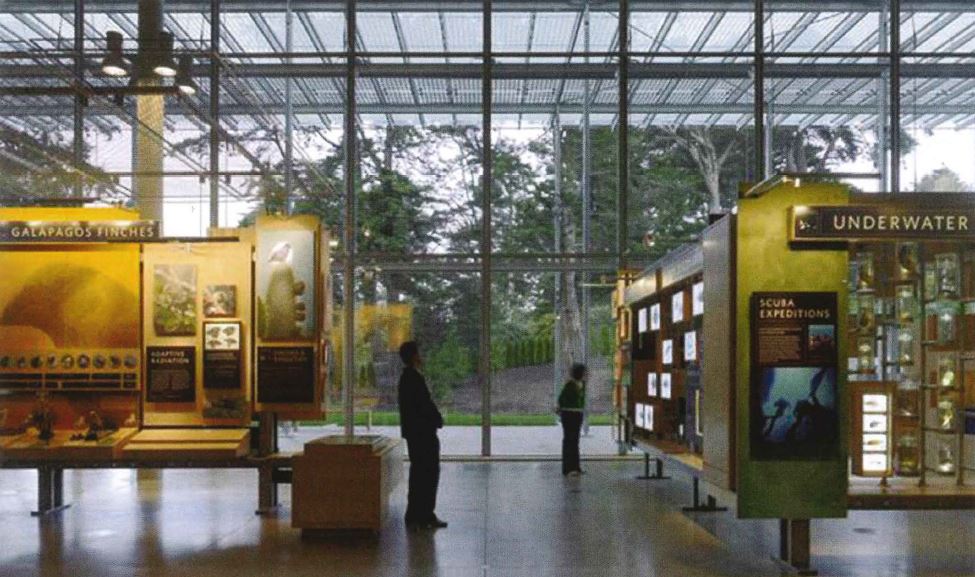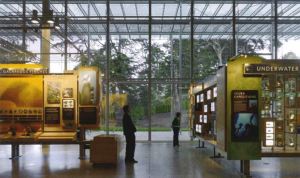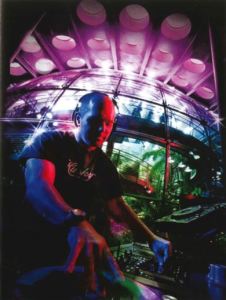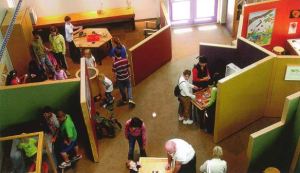
This article originally appeared in the July/August 2013 edition of Museum magazine.
How can science museums welcome grown-ups?
I don’t have children, but I like to go to science museums and play with the exhibits. You might think that there’s nothing wrong with an adult playing in a science museum. If so, you should tell that to all the parents who glare at me as I play with an exhibit they think, rightly or not, is meant for children. Audience research from consulting firm Reach Advisors has shown that a majority of museum visitors believe science museums best serve or are intended
for children. At best, this is an error in the perception of science museums by their visitors. At worst, it’s the truth.
Why does it matter if science museums are lumped together with children’s museums? The notion that people can “grow out” of science is not just tragic for individuals who feel they must “graduate” from dinosaurs to art; it has serious implications for us as citizens. Science pervades our lives, and we are asked to make important decisions that involve science (think climate change or genetically modified organisms) even as it becomes more complex.
Science museums can provide the ongoing adult science education that we all need. But only if adults feel that science museums have something to offer them.
Reaching Out to Adults
On a Monday evening, I squeeze into a venue much more familiar to the 21-plus crowd: a tiny neighborhood pub. I’m here, along with about 50 other people, to listen to a local fisheries scientist talk about sustainable marine resource management. The idea of mixing science and a casual atmosphere isn’t new. Since 2006, the PBS-produced science magazine show NOVA scienceNOWhas, with their partners, promoted these Science Cafes (which go by other names such as Science Pubs or Science on Tap and are not necessarily affiliated with NOVA). The idea is to bring scientists and the general public together in a pub or coffee house and start a conversation. The events are free and open to anyone; “No science background is required!” advertises the website for Science on Tap.
Some science museums have adopted the format, such as Seattle’s Pacific Science Center (PSC), which began hosting Science Cafes in partnership with the local public television station in 2007. “We got a grant to explore dialogue models and specifically to engage adults,” explains PSC’s Stephanie Arduini, who manages their Science Cafe program. And the result? “I would say that we have a very high repeat attendance; usually at least half of the people who come have been to a Science Cafe previously. It’s a number that has remained fairly steady even as we’ve grown our attendance,” she says. In addition, hosting the Science Cafes allows PSC to reach a different audience than that of their physical building. “It’s a very different crowd,” explains Arduini. “The main audience on site tends to be families with young kids. We see a lot of people who come to Science Cafes who are not members [of PSC].”
How about a bar in your museum? A number of museums offer “after-hours” events that invite visitors over the age of 21 to the museum to enjoy a cash bar and adult-only access to exhibits. The California Academy of Sciences in San
Francisco hosts a weekly after-hours event called “NightLife” that regularly attracts more than 2,000 people. It’s so popular that would-be attendees are advised to purchase their tickets in advance.
“It was wall-to-wall people,” recounts a local 20-something graphic designer. “The ·whole museum was open and they set up telescopes on the roof, but we didn’t get there early enough to sign up for the planetarium show …. I think there was some science stuff going on,” she added, referring to the talks and presentations by scientists and other experts “NightLife” features, “but my friends weren’t interested and it looked pretty full, anyway, so we didn’t go.”
“One of the things we try to do is appeal to adults but, within that, different groups of adults,” explains Helen Taylor, the academy’s communications manager. Each week’s theme, from salsa dancing to zombies, appeals to different interests and keeps “NightLife” fresh for people who come regularly.

The Oregon Museum of Science and Industry in Portland hosts a similar event called “OMSI After Dark,” notes Amanda Thomas, former manager of the program. “We see a lot of girl’s night out, guy’s night out, date nights…. It’s not that you dislike kids. It’s a different experience-you don’t want to shove a kid out of the way because you want to look at an exhibit. The majority of people are coming every month or a few times a year and they’re coming just for [‘After Dark’].”
After-hours events can reach audiences that are uninterested or unable to come during “regular” hours of operation. They can generate excitement, make the museum seem more inviting and serve the surrounding community as a place for social interaction. But museums should carefully consider what they are trying to accomplish with such events, notes Susie Wilkening, senior consultant at Reach Advisors. “Afterhours events are fantastic if they can accomplish the goals of both museum (to engage this audience with science) and visitor (to have an enjoyable evening out in an engaging setting),” she says. “But they can be victims of their own success if they become just another bar stop. That isn’t exactly fulfilling the museum’s mission.”
Exhibit designer Paul Orselli worries that relying on special events to draw adult visitors reinforces the perception that science museums otherwise offer little for adults. “You’re training people to respond” to the next special event, he says. Adults-only after-hours events may also have the unintended effect of creating a temporal ghetto, sending the message to adults that the museum is for them, but only after 6 p.m. “You’re not really growing your audience for your core exhibit offerings,” Orselli notes. Museums that take this route aren’t necessarily setting themselves apart from other entertainment venues adults can choose from. “If you’re going to do an event that revolves around that whole bar scenario, why just be a second-rate nightclub?” he asks. “Why not do outreach in a bar or nightclub that already has a community constituency? … I’m not saying there isn’t a role [for after-hours events], but they’re not enough by themselves.”
And the verdict of the 20-something graphics designer? She says she enjoyed “NightLife” and would definitely come to another event, but wishes they would allow fewer people in: “‘NightLife’ was so crowded I could hardly see or get to some of the exhibits.” She adds that she loved the aquarium but was “confined to a slow shuffle…. I’ll take a bar in a science museum or an aquarium over a regular club any day.” But she’d like to request more hip local DJs next time.
Planning for Adults in Exhibits
Almost 20 years after we had last stepped foot in the Exploratorium in San Francisco, my sister and I returned to indulge our mutual love of science. The space seemed much smaller and less frenetic than my childhood memory of it. We cruised from one exhibit to the next, sampling a hand-crank model of DNA here and a tornado-in-a-tunnel there. We lost track of time and were caught by surprise when the museum announced that it was only 15 minutes before closing.
How can a museum be equally captivating for children and adults? What does a museum need to provide for adults, and how can you encourage adults to engage with exhibits? Like the Exploratorium, the California Academy of Sciences must juggle San Francisco’s younger-than-average demographic. “One of the biggest challenges we have at the academy, and it has a lot to do with San Francisco as a whole,” explains Director of Exhibit Design and Production Scott Moran, “[is] that our visitorship is made up of 50 percent adults [visiting] without children and 50 percent families. So we try to build exhibits that have elements that appeal to children and elements that appeal to adults.”
Labels and interactive elements provide information and context for adult visitors, but also fun, an emotional connection and subtle humor. Live animals, found throughout the museum, also connect with adults. “As soon as you incorporate something live, it makes it appeal to everyone, regardless of age. You can engage a child who just wants to see a fish swim and an adult who wants to know more about that fish,” explains Moran.


In addition to practical considerations, like placing exhibit elements that will appeal to kids at kid height and more adult-oriented content higher up, the academy has made the conscious decision to cultivate a sophisticated aesthetic. The building is sleek and modern inside and out, with high ceilings and clean lines. It’s the work of Renzo Piano, an internationally acclaimed and award-winning architect-and it looks a bit like the inside of an Apple store. Exhibits accented with soft earth tones are set against a backdrop of glass and white surfaces. “The building in and of itself is a large draw for many adults who are fans of architecture and design,” comments Moran. “We try to think about the materials that we’re using in our exhibits…. [They have] to be of an aesthetic and design quality that’s up to par with the building. I think a lot of adults pick up on it consciously or subconsciously.”
Other museums, like Explora in Albuquerque, New Mexico, have opted for creating personal space rather than a cavernous exhibition hall. Explora founder Paul Tatter “was the brainchild behind what we did,” says Betsy Adamson, the museum’s former director of exhibits and operations. “‘Pockets’ is a nice way to put it. We have these semi-private ‘pockets’ where people can investigate, and it gives them privacy and control over their interaction with materials.”
Explora deliberately used warm, welcoming colors, natural wood, live plants and animals, and provided plenty of comfortable chairs. Their open-ended experiments are designed so that all ages can find something to interest them. “One night you’ll see these families at the interactive where all ages are engaged and the next night, it might be all adults,” Adamson says. “There’s adult night the third Friday every other month …. We have amateur astronomers who bring out their telescopes, we have a HAM radio [club]. It’s really become this nice community.” She adds that their exhibits use mostly pictures rather than a lot of words. “Some people think you need to have a lot of words,” she says, “but we haven’t found that to be the case. It just needs to be complex enough for adults.”
At the Denver Museum of Nature and Science, Senior Exhibit Developer Frances Kruger describes her approach to engaging adults: “Whenever we do exhibitions, we try to think about doing things that will appeal to a broad range of audiences. We know that one thing isn’t necessarily going to do it for everybody, so you have to have a variety of things geared to different ages and levels of interest.”
One such strategy was the three-tiered approach they took for their “Prehistoric Journey” exhibit. “Each of [the exhibit’s] three levels of interest has a consistent graphic and 3-D design approach so the levels are easily identifiable,” explains Kruger. “They are tailored to the degrees of interest and prior knowledge that visitors bring to the exhibition. They take into account developmental and cognitive stages, and even reading level, but primarily acknowledge that comprehension and enjoyment is as likely to be interest- and experience-based as age- or education-related. People may have different levels of interest on different visits, depending on the reason for visiting, mood, available time, composition of group.” She adds, “We hesitated to say, ‘This is for adults, this is for kids,’ but there’s an obvious level of correlation there.”
The museum employs another strategy in “Space Odyssey,” which, as their nomination form for the Association of Science-Technology Centers’ “Edgie” award describes, “was envisioned from the start as a seamless integration of immersive environments, hands-on interactives, live programming and digital information … with unusually flexible infrastructure, constantly updated information, permanent and portable interactive exhibits, and dynamic human presence.” A great deal of the content is communicated by volunteers called Galaxy Guides who are trained not only in subject matter but in reading their audience. “So they would interact really differently with, say, a family group with young children than they would with single adults or a group of adults or even adults with high school students,” notes Kruger.
However, the museum has noticed that regardless of target audience or the level of content, visitors perceive highly interactive exhibits as intended for children. “We’ve done a lot of evaluation,” says Kruger. “The perception is that ‘Space Odyssey’ is great for kids. It’s really ironic because much of the content is pretty high-level. … If you’ve got a science center-y environment-lots of noise, lots of interactives, lots of things going on the perception is that it’s for kids.”
Changing the Museum or Changing Perceptions?
For science museums, does the challenge lie in changing what they offer adults, changing visitors’ perceptions of what they offer; or both?
The perception that science museums best serve children could in many ways be a self-fulfilling prophecy: Visitors view the museum as best for children and show up with kids, or not at all. The museum perceives their core audience as families with children and caters their exhibits and programs to suit them. And so it goes until the museum discovers that adults don’t think it has anything relevant to offer them.
Wilkening of Reach Advisors says that science museums that want to engage adults have to understand that adults visiting without children have different motivations and emotional and cognitive needs than those visiting with children. “There are different motivations at play,” she says. “Additionally, what someone might explicitly say is their reason for visiting or not visiting might actually mask much deeper unstated desires or needs…. In our research, those unstated things tend to revolve around deeper meaning and deeper emotional connection to the stories that are being shared by a museum.”
Wilkening adds that museums should think about why an adult would choose to visit when there are many other places adults can go to learn (libraries, the Internet, TV, etc.). “Those types of things might include original objects or experiences that nobody else has,” she says, such as the space shuttles, planetarium shows or the California Academy of Sciences’ aquarium; with or without a bar.
“I think the reason the perceptions persist and the reason these challenges persist is because they’re not easy to solve; it takes constant work and persistence to resolve,” notes exhibit designer Paul Orselli. While programmatic offerings like evening events that attract adult visitors should not be seen as a one-step fix for science museums attempting to appeal to an older demographic, they can be part of a bigger plan. “Evening events for adults are part of a long-game strategy to build the foundation for more lasting relationships,” says Taylor of the California Academy of Sciences. “As people’s needs and behaviors change, our hope is that they will continue to engage with us in new ways. They may have come in the door to drink with the fishes during ‘NightLife,’ but a few years down the road, our hope is that those fond memories will keep them coming back for more-with family, for workshops, or to see a new exhibit at a museum they enjoy visiting.”
It’s important to ensure that there is something for those adults when they do come back to visit during “regular” hours. Some science museums have made the decision to focus exclusively on families with children, but those that decide to appeal to a broader audience should recognize that “children” and “adults” are not mutually exclusive audiences. Within “children” and “adults,” there is a wide range of needs, interests and motivations.
Winifred Kehl is an exhibit designer and science writer based in Seattle.







